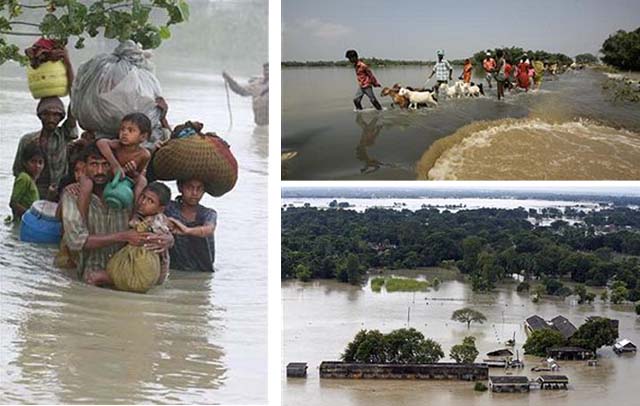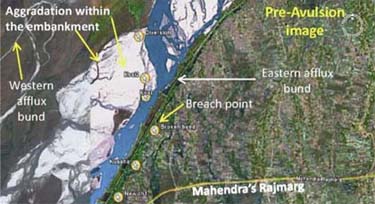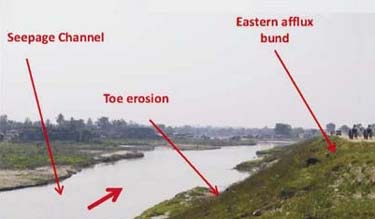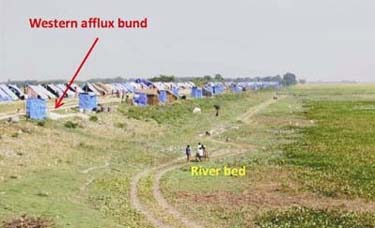Jan 01, 2026
Jan 01, 2026
Eighteenth August 2008 will go down in the history of Bihar as a bad day. For the victims of sudden flood of Kosi it will be a difficult nightmare to erase from the memory. Thousands lost their homes and hundreds were swept off by the Kosi (Also read: Revenge of Kosi). It appeared as if the enraged river could not be contained by the bund and it tore all the shackles and shifted course eastward by about around 120 km., something unheard of in the recent times.

Yes something unheard of, but nothing unusual about it. Rivers are dynamic and normally keep changing courses, because of the inherent energy and capacity to erode, scour and denude. But what Kosi did is something rare and geologists call it an avulsion. This happens when the river breaks all the rules and forcibly occupies another course.
What causes river to tear through all the shackles and take another course? Prof. Rajiv Sinha of IIT, Kanpur and an expert on river dynamics, says in one of his recent papers in Current Science, ‘such changes can be caused by natural forcing as well as human interventions, or a combination of both.’
A river normally flows through a channel it has painstakingly carved over the years; unless it is either compelled by the natural agencies or human intervention to change course. A river on an average has a certain flow and carries a certain amount of sediment depending upon the geological and geomorphological setting of the source area. But due to a change in this setting like a landslide, heavy rain in the catchments or sea level changes can increase the sediment load and make the river overflow the channel or if overstressed then even change the course.
Nature’s processes are often unavoidable, but human interventions can and should always be avoided. Often sediment load is changed due to water resource management schemes like dams, barrages and embankments. River systems are dynamic and highly integrated-a local change due to human intervention can affect the whole system.
 But the question remains: Why Kosi jumped the channel to occupy the earlier course? Several researchers like Shillingfield (1893), C.V. Gole and S.N. Chitale (1966) and N.A. Wells and J.A. Dorr (1987) had reported avulsion of Kosi River earlier also. In these ‘avulsive’ shifts the Kosi had shifted westward for about 150 km in past 200 years. These shifts of Kosi were avulsive but did not amount to actual avulsion. When a river is at or near avulsion threshold an event of sufficient magnitude (a flood) can cause the river change its channel around a nodal point, making the river shift channel from the existing one to a pre-existing one. This is what Kosi did last time and Sinha says that ‘not just Kosi, several rivers draining north Bihar are known for frequent hazards.’
But the question remains: Why Kosi jumped the channel to occupy the earlier course? Several researchers like Shillingfield (1893), C.V. Gole and S.N. Chitale (1966) and N.A. Wells and J.A. Dorr (1987) had reported avulsion of Kosi River earlier also. In these ‘avulsive’ shifts the Kosi had shifted westward for about 150 km in past 200 years. These shifts of Kosi were avulsive but did not amount to actual avulsion. When a river is at or near avulsion threshold an event of sufficient magnitude (a flood) can cause the river change its channel around a nodal point, making the river shift channel from the existing one to a pre-existing one. This is what Kosi did last time and Sinha says that ‘not just Kosi, several rivers draining north Bihar are known for frequent hazards.’
How damaging can be Kosi’s wrath can be gauged from the fact that the River jumped 120 km eastward this time to occupy an older channel. The new course forcibly occupied by the river did not have the carrying capacity to hold the volume of water, hence a sheet of water 15-20 km wide and 150 km long with a velocity of 1 meter per second kept flowing through the area for nearly four months. This new course (which used to be the course of the same river about two centuries ago could not lead this sheet of water neither to Ganga, nor back to the old stream at any point downstream. Thus a huge area remained marooned for months affecting more than 30 million people in one stroke.
 The avulsion, of highest magnitude had occurred in Kosi, triggered by a breach in the eastern bund of the Kosi at Kusaha, 12 km upstream of Kosi barrage. The mishap though most unfortunate should open the eyes of the planners and executers. Sinha calls it a ‘mega-avulsion’ rather than a regular flood.
The avulsion, of highest magnitude had occurred in Kosi, triggered by a breach in the eastern bund of the Kosi at Kusaha, 12 km upstream of Kosi barrage. The mishap though most unfortunate should open the eyes of the planners and executers. Sinha calls it a ‘mega-avulsion’ rather than a regular flood.
A river, as I have repeatedly said in my articles, is not just a conduit for water; it is a system aided by several factors and processes.
There is an old Tamil saying, which translates as ‘when an old cat sleeps, she thinks that the whole world is sleeping’. On the similar lines we construct bunds to channelize the river, to contain its water. These bunds are constructed with all the possible eventualities in mind. For example, the Kosi’s bund was designed for a discharge of 950000 cusecs, which is much more than the discharge of 144000 which on the fatal day tore through the bund wall as if it was a mere sand wall!
Based on satellite data, Sinha says, ‘Kosi River around Kusaha was flowing very close to the eastern afflux bund at least since 1999 and there are reports that a couple of spurs upstream of the breach point were eroded in the last few years’. Even a well defined seepage channel was noticed by him in the field. This channel too was eroding the toe of the afflux bund constantly. In addition a poor maintenance of the 50 year old bund probably facilitated the breach and the avulsion.
 But there was something more happening in the river. It had been aggrading the western margin at an accelerated rate after it had been jacketed by the embankment. Kosi is one of the highest sediment laden rivers in the world. It carries 0.43 mt/y/km square of sediments. As a result the river bed around the western afflux bund was at least four to five meters higher than the surrounding flood plain level. Thus it is quite possible that the river ‘off loaded’ its excess baggage (sediments) within the confines of the embankment and the river developed a higher cross valley slope than the down-valley slope in this region. This made the eastern afflux bund vulnerable and pressurized the river to threshold of avulsion.
But there was something more happening in the river. It had been aggrading the western margin at an accelerated rate after it had been jacketed by the embankment. Kosi is one of the highest sediment laden rivers in the world. It carries 0.43 mt/y/km square of sediments. As a result the river bed around the western afflux bund was at least four to five meters higher than the surrounding flood plain level. Thus it is quite possible that the river ‘off loaded’ its excess baggage (sediments) within the confines of the embankment and the river developed a higher cross valley slope than the down-valley slope in this region. This made the eastern afflux bund vulnerable and pressurized the river to threshold of avulsion.
The flood of Kosi leaves a poser for the river managers of the country and specially those of Bihar, whether the embankments will hold good and save the inhabitants from future floods or similar mishaps can occur again? The study of Sinha clearly shows that the efficacy of embankment strategy of flood control is questionable, because despite these Kosi and other rivers have been flooding and affecting a considerable chunk of humanity each year. The bunds, embankments for rail and road act more as drain obstructers than facilitators in the region, leading to vast inundations every year. Due to lack of proper drainage areas flooded remain marooned for longer periods and water logging and vector borne diseases become additional burden for the inhabitants.
The 18th August avulsion of Kosi triggered by the breach at Kusaha occurred partly due to incorrect strategies of river management and partly due to human negligence and poor maintenance of the afflux bund for last several years, says Sinha. The avulsion thus was partly a human disaster rather than regular flooding. The Kosi River has occupied a new course, is there a guarantee that it would continue to flow through that course only? Nobody in the present state of knowledge and techniques used can neither predict the next avulsion nor suggest ways to obviate it.
While suggesting possible ways to avoid future avulsions and large scale flooding, Sinha says that few other paleochannels of Kosi could be surveyed for possibilities of diverting excess water of the River through them.
Actually there is a dire need of understanding the rivers of India instead of trying to harness them mechanically through engineering solutions only. All rivers need to be understood in terms of their complete network, right from their catchments to the main rivers. Extensive use of satellite imageries and multi criteria decision support system. This will only happen if the rivers are studied with an integrated approach by team of earth scientists, hydrologists, and civil engineers with inputs from the meteorologists. Fortunately the communication network of the country is now very well developed. It is time to install monitoring systems to forewarn the masses in time to move to safer areas.
Each river may require a separate ‘treatment’. Such steps will go a long way in saving the inhabitants from the ire of the river.
15-Nov-2009
More by : V. K. Joshi (Bijji)

|
Am sorry Ketakee, I wont have the information on the Kosi embankment now. As a freelance writer on geohazards I had collected this material after the last floods of the Kosi. Once the stories were published I did not keep the data with me-because I am not a researcher. You may get in touch with Prof Rajiv Sinha of IIT Kanpur. His email id etc is available in the net. |

|
Can i get the details of the cross section of eastern embankment on kosi river whihc is approx 124 km . where protection is needed. |